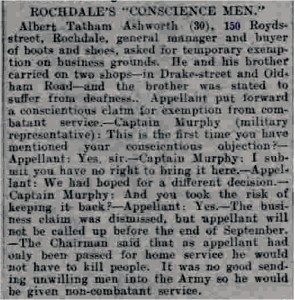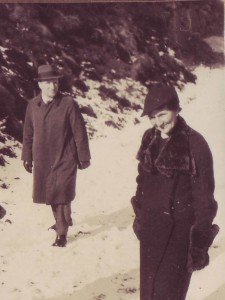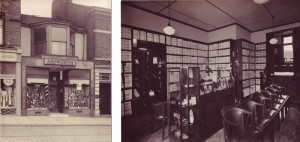Albert Ashworth, brother of Walter Ashworth was the fourth generation of boot and shoe makers and sellers to help run the Rochdale family firm. He was anxious to keep the firm going during World War One but his application for exemption on business grounds was turned down and he found himself in the Non Combatant Corps at Kinmel Park in North Wales.
The Ashworth Brothers: Albert Tatham Ashworth – From Boot Dealer in Rochdale to Boot Camp in North Wales
Posted by Ann Morgan
Family Background
Albert and his brother Walter came from a long line of boot and shoe makers and sellers in Rochdale that can be traced back to their great grandfather James Ashworth, born in 1786. The business at one stage appears to have consisted of three shops, one in Drake Street and two in Oldham Road, and these passed through the generations of the family, cousins (men and women) and brothers working together to run them.
Life before World War One
After leaving school Albert’s life was in the family business in Rochdale. The 1911 census shows him aged 24 already a shop manager – boot dealer living with his eldest brother Henry Lodge, aged 41 and a boot maker/dealer. [1] Henry is Albert’s employer. They are trading at 76 Drake Street where their father had traded before them and 263 Oldham Road from which shop their uncle Thomas Ashworth had traded. On 11 July 1911 Albert married Ellen Atkinson at the Parish Church in Rochdale. They had a son, John, born 5 August 1915.
From the report in the Rochdale Observer on 5 August 1916 it would appear that when his application looked like being unsuccessful Albert changed his application during the tribunal, putting forward a conscientious objection.
Life before World War One
After leaving school Albert’s life was in the family business in Rochdale. The 1911 census shows him aged 24 already a shop manager – boot dealer living with his eldest brother Henry Lodge, aged 41 and a boot maker/dealer. [1] Henry is Albert’s employer. They are trading at 76 Drake Street where their father had traded before them and 263 Oldham Road from which shop their uncle Thomas Ashworth had traded. On 11 July 1911 Albert married Ellen Atkinson at the Parish Church in Rochdale. They had a son, John, born 5 August 1915.
The decision and tribunal
Albert took the decision to apply for exemption from conscription. His application for temporary exemption from combatant service in 1916 was originally on business grounds. He was the general manager and buyer for the two family-owned shops and Henry was deaf. He had clearly discussed his application within the family and with his brother, Walter. We learn this from Mary Healey’s letter to Walter in which she refers to the altercation:
‘… incidentally he [Albert] told me that you had written a rather heated letter blowing him up for not thinking of your domestic affairs. It struck me that it was rather selfish on your part to blow Albert up for such a reason when he would have to be considering his own domestic affairs even before you would need to arrange yours, being the younger of the two.’ [2]

Newspaper article about Walter’s tribunal, August 1916 Reproduced with permission from the Rochdale Observer
In 1916 Albert, aged 30, would be conscripted prior to Walter who was 32. Albert’s tribunal was in Rochdale on 4 August 1916. From the report in the Rochdale Observer on 5 August 1916 it would appear that when his application looked like being unsuccessful Albert changed his application during the tribunal, putting forward a conscientious objection. The report does not indicate if it was on religious or political grounds.
The press were particularly scathing of the Non Combatant Corps, calling them the ‘No-Courage Corps.’
The Chairman of the tribunal stated that Albert had only been ‘passed for home service’. His military record gives his medical classification as B1. [3] This classification suggests that he was free from serious organic diseases, able to stand service on lines of communication in France or in garrisons in the tropics, able to march five miles, see to shoot with glasses and hear well. Thus he could have been expected to fight and could have been sent abroad. However, the Ashworth family recall that it was well known that Albert had chronic asthma and so this would account for the Chairman’s comments and have made it unlikely that he would have been sent abroad.
Albert was assigned to the Non Combatant Corps (NCC), which had been formed in March 1916 specifically for conscientious objectors. The NCC was an army unit, subject to normal military discipline, but it would bear no arms. Its members would not be required to fight or take life. They would be used in ‘the repair of roads and railways, sanitation, the provision of huts and baths for soldiers coming out of the trenches and the manufacture and provision of many necessities of life’. [4] The press were particularly scathing of the Non Combatant Corps, calling them the ‘No-Courage Corps.’
Non combatant service
On 11 October 1916 Albert reported to the NCC at Kinmel Park (4th Western) in North Wales, a camp to which soldiers were sent principally to be trained in trench warfare. It was built by McAlpine in 1915 and was the largest camp in Wales at the time. A narrow-gauge railway ran from the camp into Rhyl. At the end of World War 1 it had 21 sub camps. Next to the camp was a large system of practice trenches in Bodelwyddan Castle Park. This can still be seen. [5]
Here Albert was an army private, wore an army uniform and was subject to army discipline. His duties would have been mainly to provide physical labour (building, cleaning, loading and unloading anything except munitions). It would not have been an easy time for Albert, surrounded by men who were going to fight or who had been injured at the front and sent back to the hospital in the camp. He was, however, amongst other conscientious objectors from Rochdale. An extract from the Rochdale Observer on 20 May 1916 mentions that two local COs, Joseph Collinge and William Henry Smith, had been sent there.
Conscientious objectors at Kinmel Park who disobeyed the orders of regular army officers were court-martialled. The Liverpool Echo from 13 April 1916 records that a district court martial sentenced two privates from the NCC at Kinmel Park to two years’ imprisonment with hard labour for ‘disobeying in such a manner as to show wilful defiance of authority a lawful command…’ In June 1916 a further eight men from Newport received a similar sentence.
Albert appears to have been able to avoid this fate. His military record shows that he remained at Kinmel Park until his discharge. This was unusual as conscientious objectors were generally moved around the camps within the UK and France.
Here Albert was an army private, wore an army uniform and was subject to army discipline.
Life after World War One
After the war Albert returned to Rochdale to the family shops. His brother Henry died in 1924, aged 54 and unmarried, and Albert inherited the businesses. I believe that he worked in the shops until they were sold sometime after 1958 when the Rochdale Trade Directory shows him still trading. [6] He died in 1960 aged 73 in Rochdale. By 1964 the shop in Drake Street was owned by the Norwich shoe manufacturer Norvic, bringing an end to the Ashworth Boot and Shoe business. Ellen outlived her husband, dying in 1971 in Lancaster.
- [1] 1851 – 1911 Census.
- [2] Transcription of an undated letter from Mary Healey to Albert’s brother, Walter. By kind permission of the Ashworth family.
- [3] Cyril Pearce Database of World War 1 COs. Source NA/WO363.
- [4] Boulton, David, 2014. Objection Overruled: Conscription and Conscience in the First World War. 2nd ed. Kendal: Stramongate Press Ltd, p.131.
- [5] Clwyd-Powys Archaeological Trust Report No 1255 Twentieth-Century Military Project: Bodelwyddan Castle Park Trenches & Kinmel Park Camp Scoping Study
- [6] Rochdale Trade Directory 1958. Information provided by Rochdale Local Studies.
- Special thanks go to the Ashworth family for sharing their family archives and helping with the research for this article.



